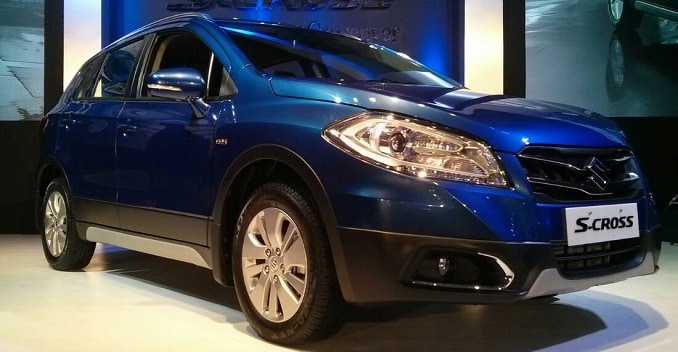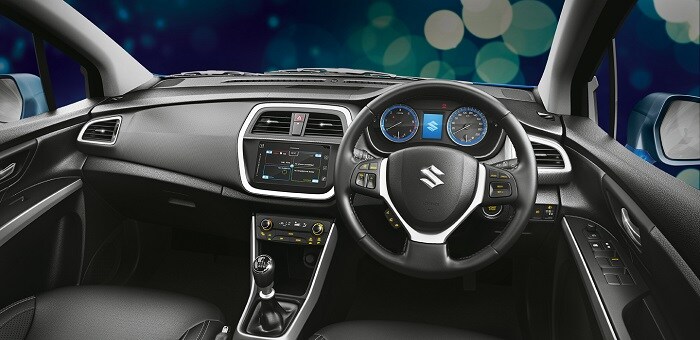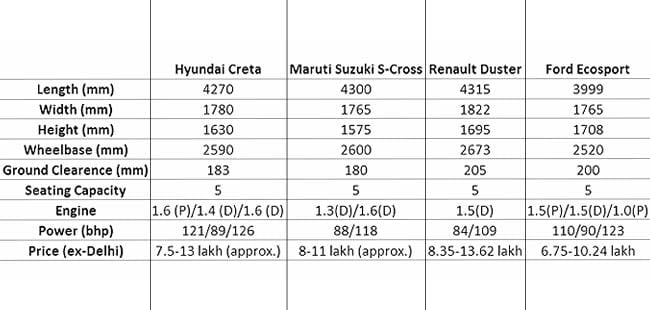 There has been a burst in the segment of compact SUVs in India and after we saw the likes of the Renault Duster, Ford EcoSportand the Nissan Terrano, there are some more surprises in this compact car segment coming soon. We recently saw the newHyundai Creta and the Maruti Suzuki S-Cross and both these cars are going to take this segment to a whole new level. We take a look at the specifications of all these competitors to check out who has the edge.
There has been a burst in the segment of compact SUVs in India and after we saw the likes of the Renault Duster, Ford EcoSportand the Nissan Terrano, there are some more surprises in this compact car segment coming soon. We recently saw the newHyundai Creta and the Maruti Suzuki S-Cross and both these cars are going to take this segment to a whole new level. We take a look at the specifications of all these competitors to check out who has the edge.
When it comes to overall length the Renault Duster has the edge followed by the the Maruti Suzuki S-Cross. The Creta comes in a close third while the EcoSport falls into the sub-4 metre segment. However, the EcoSport grabs some points back into its kitty by being the tallest car of the lot, followed by the Duster, then the Creta and finally the S-Cross.
The dimensions of the cars play a major role when it comes to the space they have on offer inside the car and this is where the measurement of the area between the wheels comes in handy. The battle of the wheelbase is won fair and square by the Duster which has 2673mm on offer while the S-Cross follows suit by offering 2600mm of usable space. The final two slots are filled by the Creta and the EcoSport.
Another thing to look at when it comes to such cars and considering that they're coming to India is ground clearance and the Duster is the clear winner here. The EcoSport comes in a close second, but the fight here is between the Creta and the S-Cross.
The Creta has more ground clearance to offer than the S-Cross and though it is a crossover, the S-Cross sits lower even than the i20 Active and the Toyota Etios Cross.
Moving on to the engines that are on offer. The Hyundai Creta will be offered with three engine options - 1.4-litre CRDi diesel, 1.6-litre CRDi diesel and 1.6-litre VTVT petrol - the Hyundai Creta will be launched in a total of four trim levels - Base, S, SX and SX (Optional). While the 1.4-litre diesel engine-equipped model will come with a 5-speed manual gearbox, the 1.6-litre diesel and 1.6-litre petrol-engined models will get a 6-speed manual and a 6-speed automatic transmissions.

The S-Cross promises a punchy 1.6 litre DDiS - sourced from Fiat - with 118 bhp on tap. In Europe the SX4 S-Cross, as it is called, also offers the choice of a CVT. The other engine on offer is the 1.3-litre DDiS which is good for 88bhp and 200Nm of torque.
Renault offers the Duster in the 1.5-litre diesel guise with two states of tune, the 84bhp and the 109bhp. The EcoSport comes with a 1.5-litre petrol, 1.5-litre diesel and the award winning 1.0-litre EcoBoost engine.
The EcoSport with the EcoBoost engine was the most powerful of the lot; however, it isn't much in demand considering it comes at a price. The Duster therefore could be considered as the powerful one in this segment but with the entry of the Creta and the S-Cross all that is about to change. The Creta is the most powerful of the lot followed by the S-Cross and this will certainly change the scenario in this segment.
The EcoSport with the EcoBoost engine was the most powerful of the lot; however, it isn't much in demand considering it comes at a price. The Duster therefore could be considered as the powerful one in this segment but with the entry of the Creta and the S-Cross all that is about to change. The Creta is the most powerful of the lot followed by the S-Cross and this will certainly change the scenario in this segment.
When it comes to pricing, all the four cars are priced closely to one another and it'll all come down to what more they can offer their customers in terms of features, safety and service. The battle is about to begin and since we've already driven the Creta, we are really interested in what the S-Cross has to offer.


Here's a list of 5 things that you should know about the S-Cross.
1. The S-Cross will not wear Maruti Suzuki badge like others cars. Instead, it will just have the Suzuki logo and model name written.
2. The S-Cross is based on the SX4 hatchback, that never came to India. However, in some European markets, the hatchback was replaced by the crossover. That said, India will only get the crossover but with some design and mechanical changes.
3. Unlike the global model's 3-piece horizontal slat grille, the Indian version will have two slats. Also, it will have increased ground clearance than the European model.
4. Since the S-Cross will share its cabin with the Swift, it will have the same all-black interiors with silver inserts.
5. The Indian version of the crossover will be powered by a different set of engines when compared to its European counterpart. While the European version is available with 1.6-litre petrol and diesel motors, the Indian version will get two diesel engines - 1.3-litre and 1.6-litre multijet - both of which have been sourced from Fiat.
Maruti Suzuki's first ever premium crossover - the S-Cross - launched in the price of range Rs. 8.34 lakh - Rs.13.74 lakh (ex-showroom, Delhi). Though it's a crossover, it will rival the Hyundai Creta, Renault Duster, Nissan Terrano, Mahindra Scorpio and other SUVs falling in the same price bracket. The S-Cross comes with two engine options - 1.3-litre multijet & 1.6-litre multijet - both of which have been sourced from Fiat.
Maruti has already received 6,000 confirmed bookings and 35,000 inquiries for the vehicle, which is available in two engine options. The 1.3-litre DDiS 200 is priced Rs 8.34 lakh - Rs 10.75 lakh, while higherpowered 1.6-litre DDiS 320 costs between Rs 11.99 lakh and Rs 13.74 lakh in Delhi. "We have got a good initial response from the market. We are targeting the premium segment for the first time as a 45 per cent market share in the passenger vehicles market leaves us vying for the other 55 per cent of market currently not with us," Maruti CEO Kenichi Ayukawa told reporters.
Price: 8.34 Lakhs - 13.74 Lakhs (Ex showroom price)




